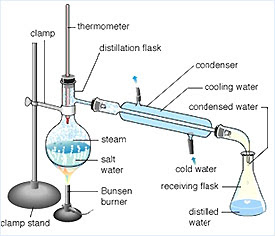Soon after it was discovered and recognized as the principle of meat smoking, wood-tar creosote became used as a replacement for the process. Several methods were used to apply the creosote. One was to dip the meat in pyroligneous acid or a water of diluted creosote, as Reichenbach did, or brush it over with them, and within one hour the meat would have the same quality of that of traditionally smoked preparations.
[15] Sometimes the creosote was diluted in vinegar rather than water, as vinegar was also used as a preservative.
[16] Another was to place the meat in a closed box, and place with it a few drops of creosote in a small bottle. Because of the volatility of the creosote, the atmosphere was filled with a vapor containing it, and it would cover the flesh.
[15]
The application of wood tar to seagoing vessels was practiced through the 18th century and early 19th century, before the creosote was isolated as a compound. Wood-tar creosote was found not to be as effective in wood treatments, because it was harder to impregnate the creosote into the wood cells, but still experiments
[17] were done, including by many governments, because it proved to be less expensive on the market.
[18]





 But this thread sure does make a guy wonder?
But this thread sure does make a guy wonder?
 . Guessing that ain't done no more and the creosote from our stacks should be tossed.
. Guessing that ain't done no more and the creosote from our stacks should be tossed.